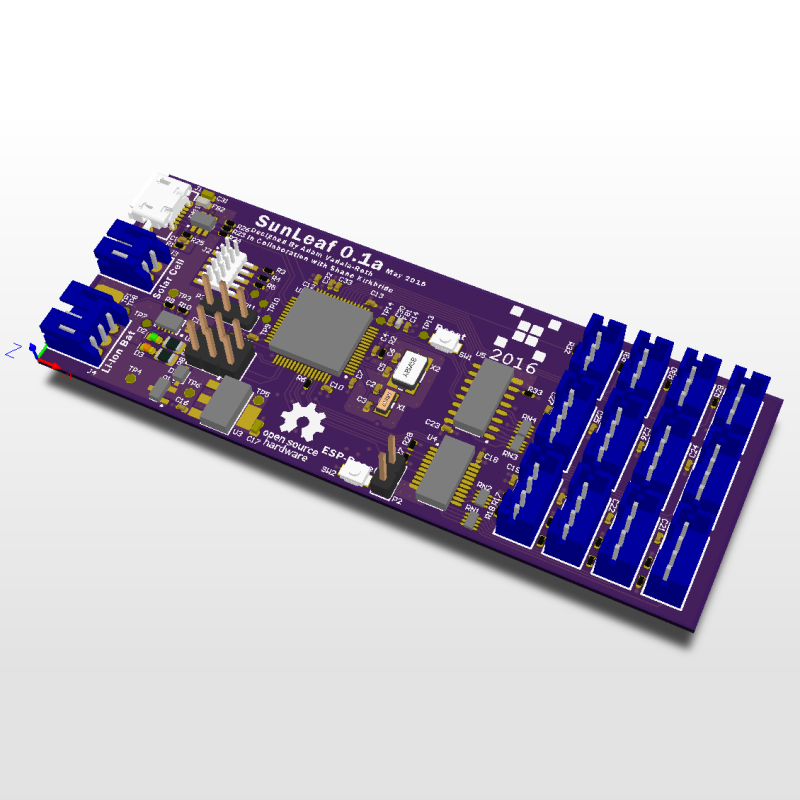If there’s one place where the Internet of Things makes sense, it’s agriculture. From vast fields of soybeans, corn, and a different variety of corn, to the backyard garden, knowing how much sun, and rain crops get can vastly increase yields. For their Hackaday Prize project, [Adam] and [Shane] are building a board designed explicitly for plants. It’s called the SunLeaf, and it has all the sensors and radios a good remote sensing board needs.
The SunLeaf is built around an ARM Cortex M4 microcontroller with an ESP8266 module for WiFi connectivity. Sensors are important for any remote sensing board, and for this the guys are going with SeeedStudio Grove connectors, providing four UARTs, four I2C, and four analog ports.For remote sensing applications, you generally can’t rely on mains power, so SunLeaf includes a port for a solar panel and a battery charger.
Although this project was originally a redesign of [Adam] and [Shane]’s Hackaday Prize entry from last year, what they’ve come up with is a great device for data logging, autonomous control, and environmental sensing for anything, from farms to weather stations.




















That USB port may be useful for a backup data store for when the link goes down, no point throwing away good data if you can send it later with time stamps. NTP is covered by the ESP8266’s capabilities so long as it can get an update every day, or whatever. How stable is the clock on the ESPs?
I think I saw someone mention somewhere that it may drift like a second a week or two. If you can update the clock from NTP even just every couple of days it’d unlikely become an enormous issue.
They could add a RTC module via I2C, in fact that can hang off the ESP.
I see 2 crystals on the board next to the micro, very likely one of them is 32kHz (did not dig through schematic) for RTC. Most big enough micros have the possibility to do this, even the “small” mega328.
You are correct one of those crystals is a 32khz crystal for the STM32 ARM internal RTC.
Yay, then you can buffer accurately time stamped data and send tit when the link is up, that may even save power as the RF part of the module would be the biggest power consumer?
While I like the idea, WiFi is not the best choice for agriculture as you will need to transmit more than a mile on many occasions. You could argue to use a high gain antenna and increase the power, but then you use more energy and need more solar, battery, size. There are other solutions for this problem that have been around for years based on industrial wireless
That is not exactly how it works, you can get many kilometres of range from WiFi just by having well aligned directional antennas. The total power does not change, it is the radiation pattern that changes. What does matter is having line of sight.
So if you look at the following link you will note the key factor will be how close to the antenna they can get the ESP8266 and how much elevation that can be given. The UART cable up to the ESP can actually be quiet long, so the WiFi module can go in the focal point of a parabolic antenna.
https://en.wikipedia.org/wiki/Long-range_Wi-Fi#Higher_gain_antennas_and_adapter_placement
Very aware of this, but this is IoT and the sensors are spread out, how many directional antennas and radios would you realistically expect them to have at the server end?
It can act as a mesh, it is all TCP/IP so routing is doable too. You can even have a mix of different link types. None of this is new.
I don’t think it is that impossible. I think the ESP was shown to reach quite a distance, maybe half a kilometer with its antenna. Since there is little data, the modules could pass it on from one to the other. There is a mesh network implemented as well. With synchronised RTC they can wake up and send the data.
However, since the ESP is not the main processor, for the same price you can swap it for a RFM69 which is a safer bet. For double the money, the RFM95 is even better.
You only need an Omni directional antenna at the server end and each of the remote units with a high gain antenna as required – or more distant modules could communicate via closer units
Sounds like a job for BATMAN! (Protocol, not comic hero)